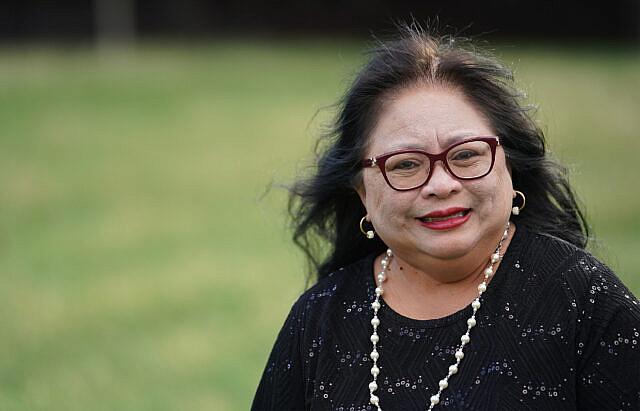The Pandemic Is Hitting Hawaii’s Filipino Community Hard
This article is part of a larger project by Anita Hofschneider, produced with support from the 2020 National Fellowship and a grant from the Dennis A. Hunt Fund for Health Journalism.
Her other stories include:
Community Leaders: State Is Failing Pacific Islanders In The Pandemic
Hawaii's Pandemic: Hardest Hit Communities Part 1: Hawaii Wanted To Save Insurance Money. People Died
Hawaii's Pandemic: Hardest Hit Communities Part 2: Health Officials Knew COVID-19 Would Hit Pacific Islanders Hard. The State Still Fell Short
Hawaii Researchers: State Must Support Pacific Islanders In The Pandemic
Pacific Islanders Have The Highest COVID-19 Death Rate In Hawaii
Women Were Already Struggling At Work. The Pandemic Is Making It Worse
Here’s What Honolulu Is Doing To Test Hard-Hit Communities For COVID-19
Kalihi Has The Worst COVID-19 Outbreak In Hawaii. Here’s How The Community Is Responding
Hawaii COVID-19 Data For Race And Ethnicity Is Missing
Hawaii Pacific Islanders Are Twice As Likely To Be Hospitalized For COVID-19
Hawaii's Pandemic: Hardest Hit Communities Part 3: Pacific Islanders Can’t Return Home During COVID-19 — Even To Bury Their Loved Ones

Jenny Delos Santos lost her job while sick with COVID-19, experiencing the double whammy of the pandemic that has hit Hawaii’s Filipino community particularly hard.
Cory Lum/Civil Beat
When Jenny Delos Santos got her COVID-19 positive test result in April, it was only the latest hit in what was already a terrible year.
Santos had been on leave from her job as a news assistant — mourning the deaths of her two adult children prior to the pandemic — when she found out she was laid off in late March. She was already sick, and got tested for coronavirus that same day.
By the time she got her positive test result more than a week later, Santos no longer had her Honolulu Star-Advertiser health insurance. As it became harder to breathe and her cough worsened, she hallucinated, seeing angels on her husband’s shoulder. She later learned hallucinations are, for some, a side effect of the virus. Despite how sick she felt, Santos didn’t want to see a doctor and risk adding to her existing medical debt.
Santos is among thousands of Filipino residents in Hawaii who have tested positive for COVID-19 since the pandemic hit the islands nine months ago. According to the state Department of Health, Hawaii’s Filipino community makes up 16% of the state’s population, but compose more than a fifth of confirmed cases. That’s the second-worst disparity in the state, behind only non-Hawaiian Pacific Islanders. As of Friday, 226 Filipinos have been hospitalized and 58 have died.
The disproportionate case counts are compounded by sky-high unemployment in Hawaii’s tourism industry, where thousands of Filipino residents work. Over the last two months, the state and community organizations have launched concerted outreach to the Filipino communities through free testing, community meetings, radio and social media.
Rochelle Mae Cadiente is among several students at the University of Hawaii who have been working with the Philippine Medical Association of Hawaii to pass out flyers at grocery stores and post information on social media to prevent spread.
“When one person is suffering, we’re all suffering,” she said.
A grassroots Filipino COVID-19 task force has partnered with various nonprofit organizations and the Filipino Community Center to use federal CARES Act funding to educate thousands of Filipino residents about the virus and how to prevent it. The group hosted a radiothon on Thanksgiving weekend and has been offering COVID-19 testing after Sunday masses in December.
Agnes Malate, a professor at the University of Hawaii, estimates the group has reached more than 20,000 people through radio, social media and in-person events since it launched its work in November. It’s racing to spend federal funds before the December 31 deadline.
“We really had to hurry up and mobilize,” she said. So far, the group’s members have noticed a crucial need for information translated into Filipino languages, with surveys finding that 75% of participants in their events speaking a language other than English.
Overcoming Stigma
Reaching Hawaii’s Filipino community isn’t always easy. On a recent Sunday, the testing site in the parking lot behind St. Joseph’s Church in Waipahu was quiet and slow. The church has a majority Filipino congregation but only about a dozen people opted to get tested.
The challenge extends to contact tracing, the process of finding people who may have been exposed to someone sickened by coronavirus. Chantelle Matagi, who leads the Department of Health’s contact tracing team dedicated to Pacific Islanders, including Filipinos, said her team frequently battles COVID-19 stigma and distrust of government.
“Much like Pacific Islanders, Filipinos have their own colonial histories which of course color how they view government entities,” said Matagi.
Many people are particularly worried that they could get in trouble with law enforcement or immigration officials. Honolulu has issued an unprecedented number of tickets to enforce stay-at-home orders.
“We have to also be very careful and reassure them that we’re not there to police, police and report,” she said. They tell people, if you cooperate with contact tracers, “You’re not going to get your relative in trouble.”

Kremlin Manuel is a Filipino immigrant and a U.S. Army National Guard member who works with Matagi on contact investigations. On a typical day, the team will contact 25 families. It can sometimes take up to two hours to speak with families and earn their trust enough to get the information they need. Sometimes, if their loved ones have died from COVID-19, the families are grief-stricken and emotional. Other times they won’t answer the phone at all.
“Number one thing is the fear, their fear of getting consequences,” Manuel said. “That’s why they don’t pick up the phone. Or putting a shame to the Filpino community. That’s another thing.”
Matagi’s and Manuel’s contact investigations team was created in mid-October and now has 20 members who speak nine languages including three Filipino languages — Tagalog, Ilocano and Cebuano. Matagi said the trends she sees in Filipino families struck with COVID-19 mirror what she sees among Pacific Islander families: they hold public-facing jobs, have pre-existing medical conditions and often lack health insurance. Many are also health care workers or work in care homes for the elderly.
Their jobs leave them no way to avoid the risk of exposure. “If you’re a nurse, you’re a caretaker, you’re working at a restaurant that’s just not possible,” Matagi said. “You have to go into work or you don’t get paid.”
Many also live in crowded or multigenerational households to afford Hawaii’s high cost of living. A 2018 state study that analyzed Census data about families who were part-Filipino — about a quarter of the state’s population — found that on average, homes owned by Filipinos include more than five people and rentals by Filipinos average more than four, higher than the state average.
Thousands Unemployed
For the first few months of the pandemic, Cadiente didn’t know anyone who was sick from COVID-19. Recently she learned one of her friends caught it, and suspects shame kept her friend from revealing that for weeks. What’s been more apparent to Cadiente is the pandemic’s economic impact. Her mother, a housekeeping supervisor at a local hotel, hasn’t been able to work for months.
She’s not alone. More than 18,500 Filipinos have filed for unemployment in Hawaii, more than any other ethnic group, according to state data. That’s not surprising given so many work in the state’s decimated tourism industry.
Bryant de Venecia, spokesman for Unite Here Local 5, says the majority of the union’s 11,000-plus members are Filipino. Many still haven’t gone back to work, and prospects are so poor for some that the union is investing in retraining for different jobs altogether.
The state unemployment data is likely an undercount of the number of Filipinos who have lost their jobs. Santos says she eventually gave up applying for unemployment after struggling with the system, and only received money briefly in June.
“It’s too hard waiting for something you never get,” she said.
She’s relied on her husband’s income, rental assistance from Catholic Charities and the generosity of her coworkers to make ends meet. She’s also ignoring medical bills she can’t afford.
Santos isn’t sure where she caught the virus, but wonders if it happened at a bus stop when she gave directions to tourists. Nine months later, she still struggles with hallucinations and isn’t sure if they’ll ever go away.
Matagi from the Department of Health says her team’s contracts have been extended until March and she hopes they are able to continue beyond that. She also hopes that people realize the communities themselves aren’t the problem, but they are in a problematic situation where they don’t have access to equitable health care.
“A lot of these disparities are due to systemic inequalities,” Matagi said.
This story was produced with support from the USC Annenberg Center for Health Journalism National Fellowship and its Dennis A. Hunt Fund for Health Journalism.
[This story was originally published by Honolulu Civil Beat.]

